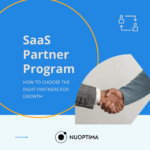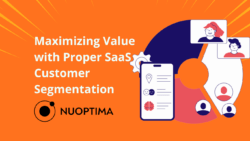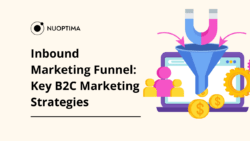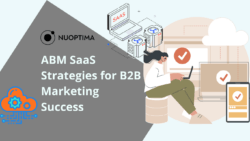Today, first impressions are formed not with a handshake but with user experience. Imagine this: a new user signs up for your software, their expectations high, and their interest piqued. They’re ready to explore what your tool can do, but where do they start? This is where the magic of onboarding comes into play. As a vital phase in the SaaS customer journey, onboarding is the welcoming party for your users, guiding them from curious newcomers to confident, engaged customers. It’s not just a process; it’s an art form – a delicate balance of education, engagement, and support that sets the tone for the entire customer relationship.
This article will journey through the critical phases of SaaS (Software as a Service) onboarding, explore the strategies that lead to success, and discover why this process is the heart of customer satisfaction in the SaaS industry. Ready to seek the expertise from our SaaS SEO agency to build lasting relationships with your users?
Navigating the Nuances: The Importance of B2B SaaS Onboarding
Imagine you’ve just handed someone a powerful, multifaceted tool. It’s brimming with features, but where’s the manual? That’s what it feels like for a new user approaching a complex B2B SaaS product without proper onboarding. Here lies the first challenge: Complexity. B2B SaaS products often boast a broad spectrum of features designed to cater to various professional needs, which, without guidance, can be overwhelming even for the tech-savvy.
Now, consider: Communication. Expressing the unique value proposition of your product and how it aligns with your customer’s specific needs is no small feat. It’s another common hurdle in the onboarding process, where clarity is the key to preventing early-stage frustration that could send users heading for the exit.
But what’s on the other side of these challenges? A world of benefits, delivered through a thoughtful, structured onboarding process.
- User Competency. By guiding customers step by step, you empower them to harness the full potential of your software swiftly and effectively. This isn’t just good for them – it’s great for you, too, as proficient users are more likely to become long-term, satisfied customers. They get to enjoy the complete benefits of your software and will likely recommend their network to you too.
- Customer Retention: The numbers speak for themselves. Studies suggest a robust onboarding process can result in 50% higher customer retention. Therefore, showcasing how and why to use a tool reduces the likelihood of them seeking alternatives, lowering churn.
Choose the Right Type of B2B SaaS Onboarding
Navigating the onboarding process of new software can be much like setting sail on uncharted waters. With B2B SaaS getting your clients onboard smoothly is paramount to ensuring a lasting relationship. But one size doesn’t fit all. So, how do you choose the right onboarding style for your customers? Let’s walk through the main approaches: White Glove, Self-Serve, and Hybrid.
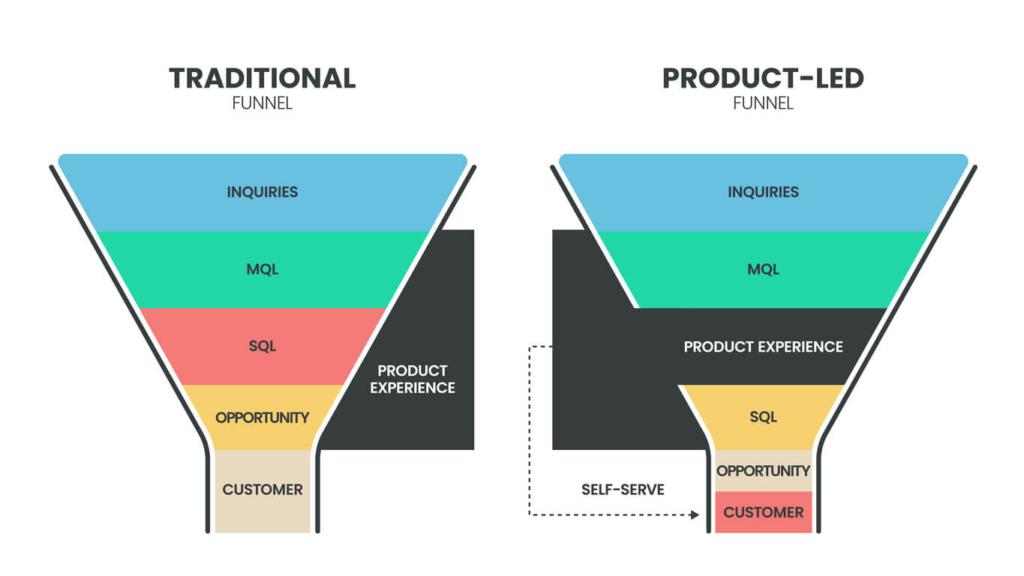
The White Glove
Suppose you have a dedicated team whose sole purpose is to guide your clients, step by step, through your software until they’re confident enough to steer the ship themselves. That’s the essence of White Glove onboarding. It’s highly customised, and it involves a substantial amount of hand-holding. Your team will set up accounts, configure settings, train users, and offer responsive support when questions arise. It’s luxurious, thorough, and perfect for clients who value a personalised touch. However, it’s not all smooth sailing, as it can be resource-intensive.
The Self-Serve
Welcome to the age of empowerment! In the self-serve model, you give your clients the tools they need to onboard themselves. It’s the digital equivalent of being handed a well-drafted map and a sturdy compass.
Self-serve works wonder for clients who prefer taking the reins and exploring at their leisure. It’s less demanding on your resources but requires a stellar user experience design. The downside? Some clients may feel adrift if they’re not natural navigators.
The Hybrid Approach
Finding the middle ground between being the dedicated captain and giving your clients complete control of the helm is the Hybrid method. This method blends the White Glove’s meticulous attention with Self-serve’s freedom and flexibility.
Here, you might kick things off with a bespoke training session or a comprehensive welcome webinar. After the initial setup and orientation, your clients are free to explore, knowing that a dedicated support team is just a flare’s signal away. It’s a balanced option, catering to clients who appreciate guidance but are eager to take the wheel as soon as they’re comfortable. It’s about setting the course together, then letting them venture forth, with the security of knowing help is always on standby.
This approach strikes a balance between resource commitment and client independence. It’s a way to say, ‘We’re with you every step of the journey, but we trust you to steer your own course, too’.
Summary Table: B2B SaaS Onboarding Approaches
| Aspect | White Glove | Self-serve | Hybrid |
| Level of Support | High (Dedicated Team) | Low (User-driven) | Moderate (Initial Support + Self-serve) |
| Resource Intensity | High | Low | Moderate |
| Personalisation | Highly Personalised | Standardised | Tailored to Some Extent |
| Cost to Implement | High | Low | Moderate |
| Customer Independence | Low | High | Balanced |
| Scalability | Low (Time & Staff Intensive) | High | Moderate |
| Time to Onboard | Longer (Hand-holding Approach) | Faster (At User’s Own Pace) | Moderate (Guided + Self-paced) |
| Example Use Case | High-value, Complex Solutions | Simple, Intuitive Platforms | Products with Varied User Needs/Goals |
Phases of B2B SaaS Onboarding
Exploring the four critical phases of the SaaS onboarding process is essential for crafting a seamless and effective user experience that not only delights new customers but also sets the stage for long-term engagement and success. The below table outlines the primary stages that you need to consider when designing this pivotal conversion stage:
| Phase | Description | Key Activities | Expected Outcome |
| Welcome and Sign-up | Makes a positive first impression and guides new users through account creation | Welcome email/message, sign-up form design, account creation/verification, welcome screen | A registered user with a verified account who has a positive initial impression of the service |
| Orientation and Education | Offers a guided tour of the software’s main features | Product tour/walkthrough, educational content (videos, articles, webinars), user interface explanation | A user who understands the basic functionalities of the software and knows how to navigate through the platform |
| Engagement and Adoption | Encourages users to dive in, actively using the software | Task prompting (e.g., “complete your profile”), goal setting and tracking, encouraging exploration of features | A user who is actively using the software, engaging with its features, and moving towards becoming a regular user |
| Feedback and Support | Collects user insights, acting as aftercare to nurture the users on their journey with your software | Surveys and feedback forms, customer support channels, monitoring user behaviour, follow-up emails | A user who feels supported and heard is more likely to become a loyal customer and provide valuable feedback |
Best Practices for Designing an Effective Onboarding Process
Designing an effective onboarding process requires careful planning and consideration. Here are some best practices to follow:
1. Personalisation is Paramount in B2B SaaS Onboarding
Treating your customers as unique individuals rather than one-size-fits-all can be your secret weapon. However, it’s more than just adding a first name to an email. It’s about genuinely understanding your customers and moulding the onboarding experience to fit their needs. Let’s delve into how to make this personal touch a reality:
Set Clear Objectives
First and foremost, define what a successful onboarding process looks like for your customer. Ask yourself, what are they hoping to achieve with your software? Is it streamlined communication, better project management, or data analysis? Setting these clear objectives will guide the design of your onboarding experience, ensuring that every step aligns with your customer’s desired outcomes.
Offer Tailored Support
Imagine having a question and getting a response that’s tailored just for you. That’s the magic of customised support. Be it through live chat, email, or dedicated customer success managers, provide avenues where customers can ask questions and get assistance when they need it most.
Know Your Customers: Segment Your Audience
To do this step right, you must know your customers inside out. What are their roles? In which industries do they operate? Use customer data to segment your audience and customise the onboarding journey based on these insights. This means that a marketing manager in the healthcare industry will have a different experience from a data analyst in retail. They get information that’s not just general but directly applicable to their roles and needs, making the onboarding journey feel like it was crafted just for them.
Communicate With Intent
Utilise email automation or in-app messaging to send unique notes to your customers at different stages of their onboarding journey. These aren’t just ‘hello’ and ‘thank you’ messages; they’re timely tips, best practices, and additional resources designed to help customers extract the most value from your product.
In essence, personalisation in B2B SaaS onboarding is about showing that you see your customers – their challenges, goals, and unique contexts – and that your platform is committed to their success right from the start. It’s not just good practice; it’s the foundation for enduring and fruitful relationships.
2. User Education and Training for Complex B2B SaaS Onboarding
Software education and training are essential to your B2B SaaS onboarding. By providing customers with actionable tips and skills to effectively use the product, you’ll increase customer satisfaction and reduce the chance of churning. Consequently, here are some ways you can educate your audience:
- Video tutorials,
- Webinars,
- Blog posts,
- Intuitive user interfaces,
- Knowledge bases,
- FAQs,
- Community forums.
- Interactive guides.
These resources should cover the basics of using the product as well as more advanced features and functionalities. By offering various training options, you’re making the process easily accessible, catering to different learning styles. It also helps to break down the onboarding process into manageable steps. Since B2B SaaS products can be complex, these resources allow customers to learn and progress at their own pace.
Furthermore, businesses should offer ongoing support such as regular check-ins with a customer success manager, access to a knowledge base or community forum, or additional training or certification opportunities. By providing continuous learning opportunities, businesses can ensure that customers stay engaged with the product and continue to derive value from it over time.
3. Multi-Channel Onboarding
A multi-channel onboarding strategy ensures your product stays at the forefront of users’ minds, particularly during a free trial, enhancing engagement and conversion rates. You’ll want to craft regular, engaging communications through various channels, such as targeted emails, social media posts, and in-app messages – for example, a simple email nudging users to explore a specific feature they haven’t used yet.
Here are some external touchpoints to consider:
- Welcome Message: After sign-up, warmly welcome users and guide them to a quick-start tutorial.
- Progress Check-Ins: Midway through the trial or after signing up, ask about their experience and if they need support.
- End of Trial Reminder: As the trial ends, encourage them to subscribe, underscoring the benefits of continuing.
To make multi-channel marketing work in your onboarding system, automation is essential. Not only does it save you time and reduce errors, but it makes it simple to scale this process as you grow. If you’re automating emails, ensure messages feel human, such as addressing the user by name and referencing their specific use case.
4. Onboarding Doesn’t End When Users Sign Up
Remember that the onboarding process doesn’t end with a free trial. After a user converts from a free to paid version of your software, they should continue to receive support and guidance. While the frequency may reduce, it’s pivotal you continue nurturing them with practical help and excellent customer service. Prioritising the after-sales experience proves to your existing customers that you value their investment, thus, improving brand loyalty, customer satisfaction, and the chance of getting referrals.
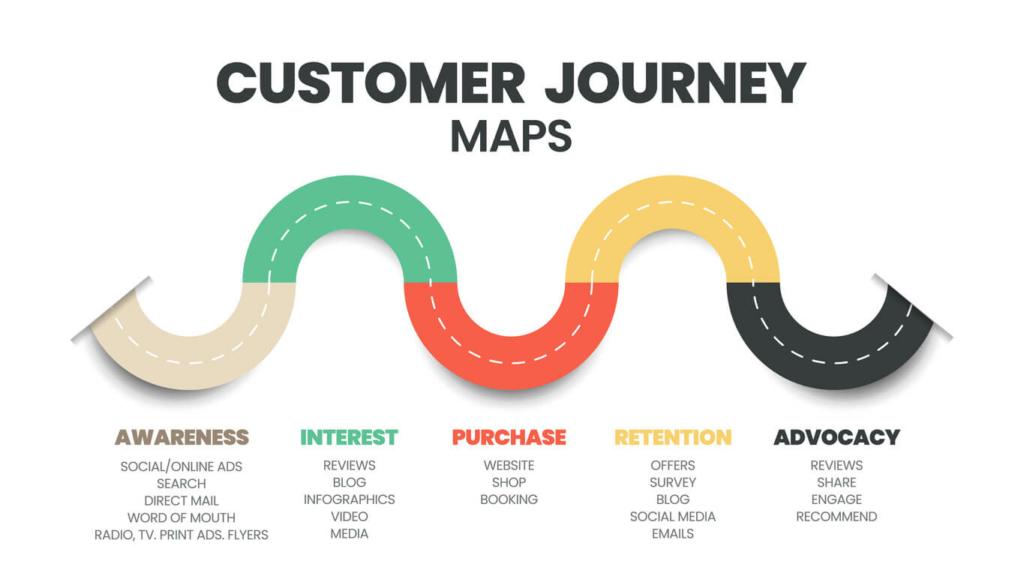
5. Measuring Onboarding Success: Key Metrics to Track
To measure the success of the onboarding process, businesses should track several key metrics:
- Time-To-Value: Use this to measure the time it takes for a user to see value from using the product. For example, a shorter time-to-value indicates a more successful onboarding process. By analysing this metric, businesses can identify bottlenecks or areas of friction in the onboarding process and take steps to streamline them.
- User Engagement: This metric measures how actively customers use the product during onboarding. High user engagement indicates that customers find the product useful and are likely to continue subscribing. By monitoring user engagement, businesses can identify customers at risk of churn and take proactive measures to address their needs.
- Customer Satisfaction: This metric measures customers’ satisfaction with the onboarding process. It can be measured through surveys, NPS scores, or customer feedback. High customer satisfaction indicates a successful onboarding experience.
- Churn Rate: The percentage of customers who cancel their subscription or stop using the product after the onboarding process. A low churn rate indicates a successful onboarding process, but a high one may suggest changes need to be made.
By tracking these metrics, businesses can gain insights into the effectiveness of their onboarding process and make data-driven decisions to optimise it.
The Role of Customer Feedback in Onboarding Optimisation
Customer feedback optimises the onboarding process, so every step provides value and builds trust. There are numerous ways to collect customer feedback during the onboarding process:
- Surveys,
- Interviews,
- User testing sessions.
These mediums can provide valuable insights into the customer’s experience, highlighting areas of friction or confusion. Businesses can also leverage in-app feedback tools or chatbots to collect real-time customer feedback as they navigate the product.
Once feedback is collected, businesses should analyse it to identify common themes or patterns. This can help prioritise areas for improvement and guide the design of iterative changes to the onboarding process. By involving customers in optimisation, businesses can ensure that the onboarding experience meets their needs and expectations.
Examples of Excellent Onboarding
There are numerous examples of great onboarding experiences. Take Hubspot, for instance. Upon a new user’s registration for their CRM software, they are presented with the option to explore a complimentary premium demonstration or commence utilising Hubspot’s collection of free utilities. Self-segmentation is the primary design choice from the start of this onboarding experience as leads split themselves up into two categories. Next, during the questionnaire, they are segmented further by letting the platform know if they are setting up an account for individual use or for a team.
These quick details help personalise their account from the get-go and let the marketers behind the scenes tailor messaging to the user’s circumstances. Consequently, this tactic makes the experience more relevant and useful, thus increasing their satisfaction with the platform.
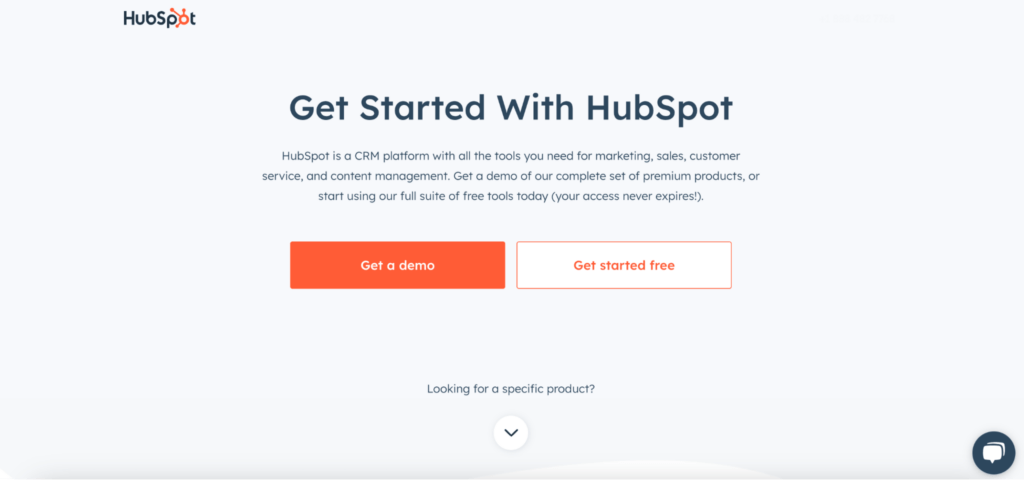
Another great example is the task management platform, Asana. During their early sign-up stage, users are prompted to input their main objective of using the platform. With this information, Asana can segment their audience and tailor their messaging to that specific goal.
To take the experience to the next level, the platform guides the user through an interactive tutorial showing them how to set up their first project.
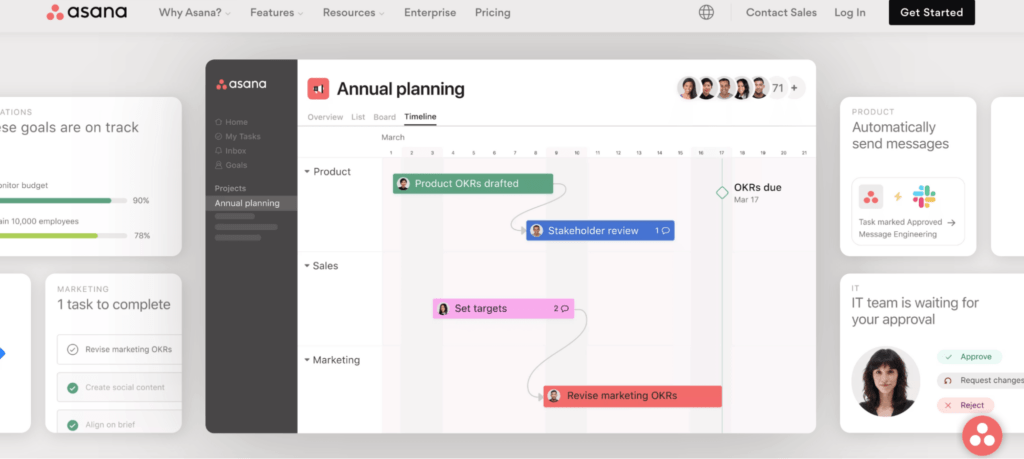
As you can see, how you design your B2B SaaS onboarding strategy will vary depending on your audience and the outcome you wish to achieve. Nonetheless, some things remain vital, such as the need for segmentation, personalisation, and continued support.
To gain further insights on ROI strategies, listen to an engaging conversation in the Nuoptima SaaS Podcast featuring Deepak Prabhakara from BoxyHQ.
Conclusion: The Future of B2B SaaS Onboarding and Customer Retention
As you’ve discovered, B2B SaaS onboarding plays a critical role in customer retention. By guiding them through the initial setup and training, businesses can help users realise the product’s value and increase their chances of long-term success.
However, while the SaaS industry tends to favour a self-serve plan, be sure to design a B2B SaaS onboarding strategy that aligns with your customer base. For example, you might consider the value of a dedicated customer service team to quickly diffuse any doubts or queries. Whichever method you do, developing a seamless transition from a free trial to a paid subscriber plan is vital.
If you’re struggling to attract qualified leads to your B2B SaaS product, you’ll want to meet NUOPTIMA, our growth agency and a proficient SaaS consulting agency. Our growth agency understands the importance of a targeted strategy and helping you build a sustainable and predictable revenue stream. Book a free call today and get chatting with our in-house experts about attracting ready-to-buy consumers to your product.
FAQ
The SaaS onboarding process unfolds in four key phases. First, the Welcome and Sign-up phase makes a positive first impression and guides new users through account creation. Next, Orientation and Education offers a guided tour of the software’s main features. Then, Engagement and Adoption encourage users to dive in, actively using the software. Finally, the Feedback and Support phase collects user insights, acting as aftercare to nurture the users on their journey with your software.
A SaaS onboarding strategy is a structured plan guiding new users from sign-up to loyal customers. It starts with setting clear goals, segmenting users, and tailoring the experience to their needs. You can also incorporate tutorials, educating users with engaging content.
Onboarding is vital in SaaS for several compelling reasons. It sets the initial tone, as first impressions matter greatly. Effective onboarding boosts user retention, helping users quickly see the software’s value and reducing churn. Furthermore, a smooth onboarding improves customer experience, helping them get the most from your service and increasing the likelihood of getting referrals.
